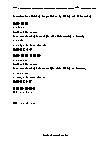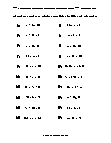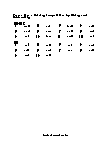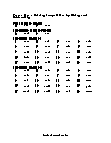Solving Inequalities by Adding or Subtracting Worksheets
How to Solve Inequalities by Adding or Subtracting Inequality is used to establish a comparison between the two things. When we compare two things that are not equal, we term the comparison as an inequality. However, in mathematical terms, inequality is a bit different. In math, when we term a comparison as an inequality, we mean one of the following things. Considering we have two things 'a' and 'b' to compare, and inequality is when one object is: Greater than the other (a > b that is object a is greater than object b). Smaller than the other (a < b that is object ais smaller than the object b). Not greater than the other (a ≤ b that is the object a is not greater than the object b, or it is smaller or equal to b). Not smaller than the other (a ≥ b that is the object a is not smaller than object b, or bigger or equal to b). We can solve the inequalities by operating with addition, subtraction, multiplication, and division. Operating with inequalities is the same as working with the traditional equations. Like you add and subtract, multiply or divide in the regular equations, you can work the same with inequalities. The process used to solve in equations to find out the unknown can also be used with inequalities to find out the unknown. Consider the example below: x + 7 > 17 , x + 7 -7 > 17 – 7 = x > 10. Consider another example: b – 14 ≥ - 8, b – 14 + 14 ≥ -8 + 14 = b ≥ 6.
-
Basic Lesson
Demonstrates how to solve inequalities by adding or subtracting. Practice problems are provided. x + 8 < 0 Combine like terms: i.e. transferring 8 to right side Subtracting 0 from 8, x < 0-8.
View worksheet -
Intermediate Lesson
Explains how to solve inequalities by transferring numbers. Practice problems are provided.
View worksheet -
Independent Practice 1
Contains 20 solve inequalities by adding or subtracting problems. The answers can be found below.
View worksheet -
Independent Practice 2
Features another 20 solve inequalities by adding or subtracting problems.
View worksheet -
Homework Worksheet
12 solve inequalities by adding or subtracting problems for students to work on at home. Example problems are provided and explained.
View worksheet -
Topic Quiz
10 solve inequalities by adding or subtracting problems. A math scoring matrix is included.
View worksheet
What Is It?
An inequality is an expressions used in algebra. It is
used when what the expression is equal to is unknown. Instead of an equals
sign, one of these symbols is used:
> greater than
< less than
≤ less than or equal to.
≥ greater than or equal to.







